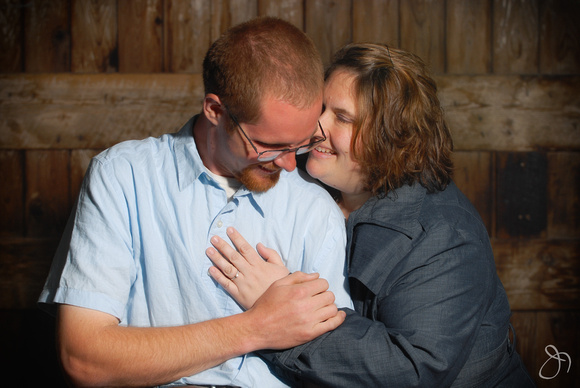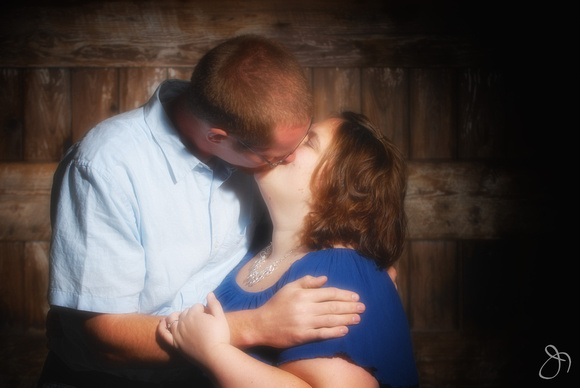Benefits of "Location-Only" or Environmental Portraits
Family portrait on location, no studio -- © Joel Nisleit 2012.
I've had parents call for senior portraits, and when they found out I didn't have a studio, I never heard back. That was unfortunate -- for them. People are so used to the idea of sitting in a studio filled with backgrounds, props and lights that they think that's all there is to photography. But when they get there, they freeze up, intimidated by the whole setup. Fortunately, there's so much more to photography than the studio, all you need to do is open your eyes and see it.
Of course, on-location or environmental portraits have been done for decades. You know this if you're married. Weddings are typically shot on location, outdoors, with minimal equipment. If we can do great portraits in those conditions, why would it be any different for anyone else wanting a portrait and it happens to be on location?
One reason I think people are nervous about environmental portraits is they forget a professional is behind the lens. It's a horrible misconception that if a photographer doesn't have a studio he's not professional. Plenty of professionals, including myself, make great art outside of the studio, and many would never want to be caught in one. The difference between a snapshot and a professional portrait is understanding photography, the actual art of painting with light. It's not the location. You could put a hundred amateurs in the same location with the same equipment and get mediocre results. It doesn't matter whether you're in a basement -- in which, by the way, I took my self portrait for this website -- outside or in a studio. What matters is that the professional understands photography and can apply it to the situation.
For example, look at the shot below. There's no studio lights, no fake background, no digital backdrop. It's all on location in a crusty barn with horrible lighting. But I made it happen. I had given the couple direction but when they drifted off course and started playing around, did I stop shooting? Heck no. I snapped away. A little enhancement later, and those shots became timeless moments shot in the crummiest of conditions that -- guess what -- didn't matter one bit because I knew how to shoot and enhance it.

 Captured on location in front of an old barn door. The barn is part of the man's life and incorporating it not only provided a naturally interesting backdrop but adds meaning to the photograph for the subject.
Captured on location in front of an old barn door. The barn is part of the man's life and incorporating it not only provided a naturally interesting backdrop but adds meaning to the photograph for the subject.

 Another example of a moment captured in that natural environment. No digital backgrounds. No 20-lb. lights. No studio. Just a crusty old barn with horrible lighting, transformed by portable Speedlights and some software.
Another example of a moment captured in that natural environment. No digital backgrounds. No 20-lb. lights. No studio. Just a crusty old barn with horrible lighting, transformed by portable Speedlights and some software.
 Here I simply tracked the couple as they walked around the resort not paying much attention to me. The result is a moment where the bride tosses a smile over her shoulder. We don't know why or to whom, but it's interesting, and she pops against the big dark sky. Is the groom partially cut off? Yes, but who cares? This is all about the bride's moment, the emotion you couldn't recapture in a thousand posed repeats.
Here I simply tracked the couple as they walked around the resort not paying much attention to me. The result is a moment where the bride tosses a smile over her shoulder. We don't know why or to whom, but it's interesting, and she pops against the big dark sky. Is the groom partially cut off? Yes, but who cares? This is all about the bride's moment, the emotion you couldn't recapture in a thousand posed repeats.
 I know a lot of us still like posed shots. They have their place. This shot was posed. It's good, but is it as charming as the moments between moments, where the subjects are captured doing something spontaneous?
I know a lot of us still like posed shots. They have their place. This shot was posed. It's good, but is it as charming as the moments between moments, where the subjects are captured doing something spontaneous?
Environmental portraits provide things the studio can't. Putting the subject in her natural context, for example, is impossible to do in a studio. Sure you can lay out all her sports memorabilia in an interesting way, and you can drop in a digital background with a lot of work, but that's not as good as putting the girl outside on the pitcher's mound or on the bleachers, or on the basketball court. You don't take a portrait of a welder in a studio. You take it in his work environment where you can capture the grit of the tools of the trade in a more natural way. And there's nature everywhere that makes for beautiful settings and backdrops without the need to cram everyone into a studio. With portable strobes, understanding of photography and proper use of software, we can make almost anything happen.
Environmental portraiture also offers dynamic settings that are never the same. Even the same spot in a park at the same time of day will not look exactly the same two days in a row. Not with one hundred repeats could you get the exact same shot. You get something different every time, keeping things interesting and ensuring you never see the same exact portrait twice.
The only difference between location and studio is consistency and control. The studio is an old standby. It enables the photographer to completely control every element. It's a consistent environment both in lighting and weather. But what happens as a result of that control? You instantly know the shot was taken in a studio. The poses are, well, poses.
Amateurs are obsessed with the idea of perfect poses. But the best photographers know that poses aren't the answer. The best shots are moments, directed or not, that occur without us positioning each limb and tilt of the head. They show the subjects doing something spontaneous and portray a moment so fluid and emotional it could never be replicated in a studio or even five seconds later. Wouldn't you want that for your senior, family or individual portrait?
I've never thought of the studio as a place of comfort. If you've ever felt comfortable in a studio, was it because of the studio or the photographer? Again, the professional makes the difference, not the location. It's rather uncomfortable, in fact, to be the focus of attention under lights and backdrops and props. It takes more work to make a subject comfortable in that situation that it does outdoors or in the subject's own environment. A good photographer can make you comfortable anywhere, probably more easily outside of a studio.
I want to direct a movie with you in it, not pose you like a puppet. The thing I hate most about poses is that I instantly know they were posed. There's no way around it. A pose is a pose. But a moment is a moment; you can direct it, but you can't fake it. I want a fluid environment where I can capture something natural about the subject. It could be a reaction, a look or a movement that isn't posed. Most of the wedding shots I posed are not as good as the ones after the pose -- the moment between moments. Maybe the original shot is over and a new moment happens all on its own. That's what I capture. Moments, emotions, light -- that's what it's all about.

